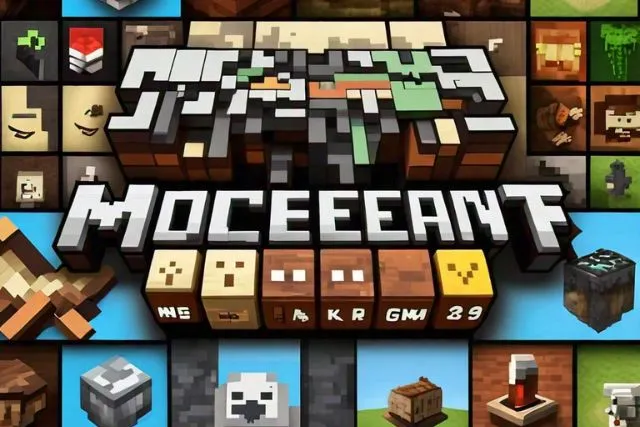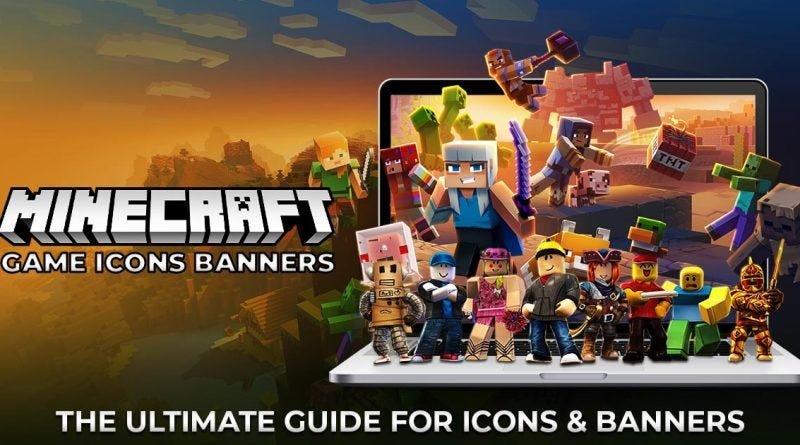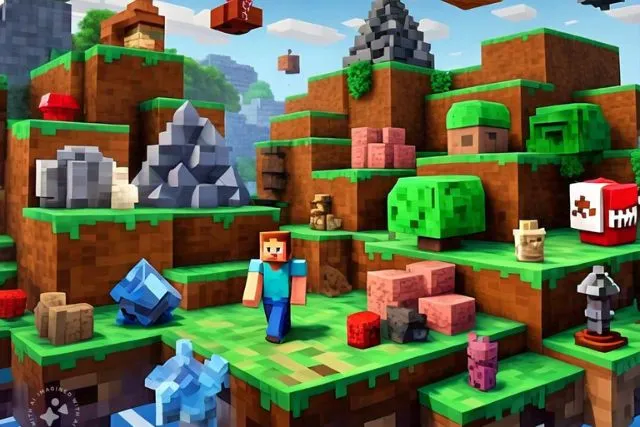Minecraft, released in 2009, has evolved from a modest indie game into a global sensation, captivating millions of players with its boundless creative possibilities. Among the many features that contribute to the game’s enduring appeal are the game icons and banners. These elements have become integral to player identity, community interaction, and the game’s visual language.
This guide delves into the intricacies of “Minecraft (2009) game icons and banners”, offering insights into their creation, significance, and impact within the game.
Minecraft Popularity and Usage Stats
As of 2025, Minecraft has over 150 million active players worldwide, making it one of the most popular games globally. Custom banners are a favorite feature among multiplayer players, with over 35 million players using banners to mark territories, represent factions, or decorate their bases. With 16 million color combinations and countless pattern possibilities, players have nearly unlimited creative freedom in banner design.
Understanding Minecraft (2009) Game Icons and Banners

The Role of Game Icons
Game icons in Minecraft serve as vital visual cues that enhance gameplay. They represent everything from resources, tools, and weapons to mobs and environmental hazards. Each icon is meticulously designed to convey information quickly, ensuring players can make informed decisions without disrupting their gameplay experience. For example:
- Resource Icons: Indicate materials like wood, stone, and ores.
- Tool and Weapon Icons: Represent the various tools and weapons available for crafting and combat.
- Mob Icons: Identify different creatures, both friendly and hostile, within the game.
- Health and Hunger Icons: Show the player’s health and hunger levels, crucial for survival.
- Achievement Icons: Celebrate player milestones and accomplishments.
The Significance of Banners
Banners in Minecraft are customizable flags introduced in version 1.8. They are crafted using six pieces of wool and a stick, offering an extensive range of colors and patterns for personalization. Banners serve multiple purposes:
- Territory Marking: Players use banners to signify ownership of certain areas.
- Decoration: Banners add aesthetic value to structures and spaces within the game.
- Allegiance Signaling: In multiplayer servers, banners represent faction identities and allegiances.
Crafting Your First Banner
Creating a banner in Minecraft is a straightforward process:
- Gather Materials: Collect six pieces of wool of the same color and one stick.
- Craft the Banner: Arrange the wool and stick it in a crafting grid to create a blank banner.
- Customize Using a Loom: Place the banner in a loom and add dyes to create patterns. Players can layer multiple patterns to achieve complex designs.
Exploring Banner Designs
The variety of banner designs in Minecraft is vast. With over 16 million possible color combinations and numerous pattern layers, the potential for creativity is limitless. Some common patterns include:
- Stripes and Borders: Basic designs that add simplicity and elegance.
- Figures: More intricate designs such as skulls, flowers, and crossbones.
- Gradients: Create a smooth transition between colors.
Iconic Game Icons and Their Meanings
Certain game icons in Minecraft have become iconic, representing key elements of the game’s lore and challenges:
- Creeper Face: Symbolizes danger and caution due to the explosive nature of creepers.
- Ender Dragon Egg: Represents achievement and the completion of one of the game’s most challenging tasks.
These icons are more than just graphics; they are embedded with meaning that enhances the player experience, facilitating non-verbal communication within the Minecraft community.
The Importance of Banners in Minecraft Factions

In multiplayer servers, banners play a crucial role in faction dynamics. Factions, or groups of players working together, use banners to:
- Establish Identity: Banners act as a visual representation of a faction’s ethos and goals.
- Mark Territory: Banners are used to claim and defend areas within the game world.
- Foster Unity: By rallying under a common banner, factions strengthen their bonds and build a sense of community.
Effective Use and Display of Banners
To maximize the effectiveness of banners in Minecraft:
- Strategic Placement: Position banners in high-visibility areas such as base entrances, towers, and territory borders.
- Functional Use: Use banners as waypoints or markers for significant locations or resources.
- Visibility: Ensure that the banner’s design is easily recognizable from a distance.
Tips for Designing Minecraft Game Icons
Designing effective game icons requires careful consideration:
- Purpose Identification: Understand the icon’s intended use before beginning the design.
- Simple Shapes: Use clear, simple shapes that are easily recognizable at small sizes.
- Color Selection: Choose colors that stand out against Minecraft’s environment.
- Incorporate Game Elements: Ensure relevance by including elements from Minecraft’s world.
- Test in Game: Evaluate the icon’s effectiveness in various in-game scenarios.
- Community Feedback: Seek input from the Minecraft community to refine the design.
Banner Customization Tools and Resources
Several online tools and resources can assist in creating unique banners:
- NeedCoolShoes: A popular banner design simulator that allows players to experiment with different patterns and colors.
- Minecraft Forums: A hub for sharing designs, templates, and ideas with the broader community.
- Social Media Groups: Platforms like Reddit and Discord offer spaces for collaboration and inspiration.
These resources not only aid in banner creation but also foster a sense of community and shared creativity among players.
The Role of Icons in Minecraft’s Visual Language
Icons are the cornerstone of Minecraft’s visual language:
- Resource Identification: Icons help players quickly identify materials and tools.
- Danger Warnings: Icons signal potential threats, allowing players to take precautionary measures.
- Achievement Recognition: Icons celebrate milestones, enhancing the sense of accomplishment.
- Navigation: Icons assist in navigating Minecraft’s vast world, guiding players to specific locations.
Community-Created Banners and Their Impact
The Minecraft community’s creativity has led to a rich array of custom banners:
- Collaboration: Community members share designs and techniques, fostering an environment of collaboration.
- Inspiration: Player-created banners inspire others, driving creativity and innovation.
- In-Game Politics: On multiplayer servers, banners influence faction dynamics, alliances, and rivalries.
Conclusion
Minecraft (2009) game icons and banners are more than just decorative elements; they are integral to the game’s identity and player experience. Through their creative use, players can express themselves, establish identities, and engage with the community on a deeper level. The continued evolution of these elements, driven by both the developers and the passionate Minecraft community, ensures that they will remain a vibrant part of the game’s culture for years to come.
As we explore the endless possibilities within Minecraft, we celebrate the creativity, ingenuity, and collaboration that these icons and banners represent.
FAQs on Minecraft (2009) Game Icons and Banners
1. What is the role of game icons in Minecraft?
Game icons in Minecraft act as essential visual aids that enhance the gameplay experience. They represent various elements such as resources, tools, weapons, mobs, and player stats. For example:
- Resource Icons: Indicate materials like wood, stone, and ores.
- Tool and Weapon Icons: Showcase items for crafting and combat.
- Mob Icons: Identify different creatures within the game.
- Health and Hunger Icons: Display vital survival stats.
These icons ensure players can access information quickly and make informed decisions during gameplay.
2. What are banners in Minecraft, and what are they used for?
Banners in Minecraft are customizable flags introduced in version 1.8. They are crafted using six pieces of wool and a stick, and they serve several purposes:
- Territory Marking: Signify ownership of areas.
- Decoration: Enhance the visual appeal of structures.
- Allegiance Signaling: Represent factions or groups in multiplayer servers.
3. How can players create banners in Minecraft?
Creating a banner in Minecraft is simple:
- Gather Materials: Collect six pieces of wool (same color) and one stick.
- Craft the Banner: Arrange the wool and stick it in the crafting grid to create a blank banner.
- Customize: Use dyes to add patterns and personalize the banner.
4. Why are banners important in multiplayer Minecraft servers?
In multiplayer servers, banners help signify allegiance and identity. Players use them to represent factions, teams, or groups, making them a key part of in-game communities and collaborations.
5. How do game icons enhance player experience in Minecraft?
Game icons provide quick and clear information about resources, tools, and player stats without interrupting gameplay. For instance, achievement icons celebrate milestones, while health and hunger icons help players monitor survival metrics, enhancing both strategy and immersion.
